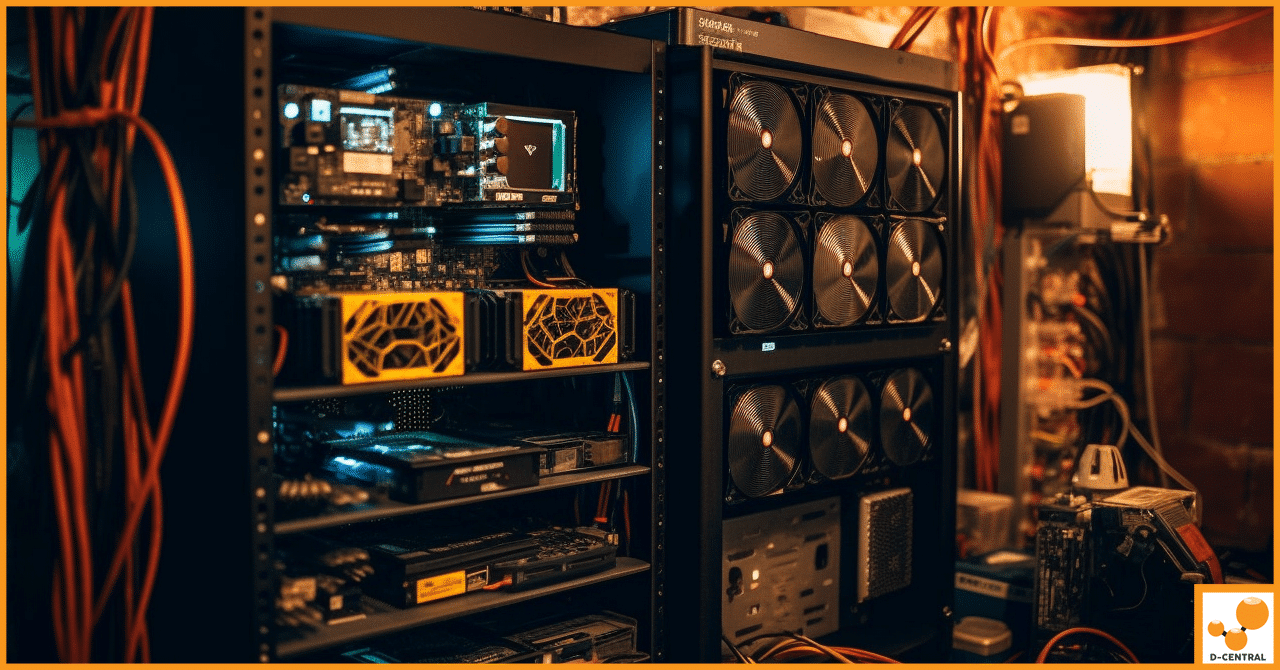
Optimizing Home Cryptocurrency Mining with HVAC
Discover how D-Central Technologies is transforming residential spaces with innovative Bitcoin mining solutions that double as efficient heating systems. Learn
4479 Desserte Nord Autoroute 440, Laval, QC H7P 6E2

Bitcoin mining, the process of validating transactions and securing the Bitcoin network, is a cornerstone of the cryptocurrency’s infrastructure. This process is known as the process called mining, where miners compete to solve complex cryptographic puzzles in a race to add new blocks to the blockchain. It is highly competitive, as each miner aims to be the first miner to solve the puzzle and earn the block reward. Bitcoin mining work involves using cryptography, encryption, and distributed computing to verify and secure transactions within the network. To successfully mine bitcoin, miners must find a hash below the target hash, which is a threshold set by the network’s difficulty. This complex computational task not only facilitates the verification of bitcoin transactions and their addition to the blockchain, but also allows miners to record transactions on the public ledger, ensuring transparency and immutability. By doing so, miners help secure transactions using advanced cryptographic methods. The process also leads to the creation of new bitcoins, as miners mine bitcoin by competing to solve cryptographic puzzles. Mining cryptocurrency requires specialized hardware and significant computational effort. Crypto mining also plays a crucial role in preventing the double-spending of digital currency on a distributed network. However, as Bitcoin’s popularity has soared, so too has the difficulty of mining, making it increasingly challenging for individual miners to compete.
Enter Bitcoin mining pools. These pools are collaborative groups where crypto miners combine their computational power to enhance their chances of successfully mining Bitcoin. By working together, pool members increase their collective hashing power, significantly boosting their probability of solving a block and reaping the rewards. Mining pools help individual miners compete against other miners with greater resources. Miners are incentivized to secure the network by participating in the transaction validation process, which increases their chances of winning newly minted coins. The rewards are then distributed among the pool members, typically in proportion to the amount of computational power each contributed.
Understanding the dynamics of mining pools is crucial for anyone involved in Bitcoin mining. Key concepts such as ‘luck,’ ‘shares,’ and ‘estimated hashrate’ play a pivotal role in how mining pools operate and how rewards are allocated.
In this article, we delve deeper into these concepts, exploring how they interplay to shape the Bitcoin mining pool ecosystem. Understanding these elements is not just a matter of technical curiosity but a necessity for anyone looking to participate effectively and profitably in Bitcoin mining.
A Bitcoin mining pool is a collaborative effort where individual miners pool their computational resources over a network. This collective approach is designed to increase their chances of successfully mining Bitcoin and earning block rewards. In essence, a mining pool is a network of miners who agree to share block rewards in proportion to their contributed mining hash power. New participants can start bitcoin mining by joining a pool and using appropriate mining devices, such as ASIC miners, to contribute their computational power.
The primary purpose of a mining pool is to aggregate the hashing power of individual miners, making it more likely for the pool to solve the cryptographic puzzles required to mine a new block. This collaborative effort not only increases the frequency of block discovery but also stabilizes the reward earning process. Without pools, individual miners with limited resources might find it extremely difficult, if not impossible, to compete with more powerful, well-resourced miners or organizations.
The Evolution of Mining Pools Over Time
The concept of mining pools emerged as a response to the increasing difficulty of mining Bitcoin. In the early days of Bitcoin, mining was feasible on personal computers and required relatively less computational power. However, as Bitcoin gained popularity and the network grew, the difficulty of mining increased exponentially, necessitating more powerful and specialized hardware.
The first Bitcoin mining pool, “Slush’s Pool,” was introduced in 2010. Slush’s Pool was the pioneering pool that revolutionized Bitcoin mining by allowing individual miners to contribute to block solving and share in the rewards. This pooling of resources was a game-changer, democratizing mining to some extent and allowing individuals to participate profitably. Slush’s Pool holds historical significance as it enabled broader participation and set the foundation for future mining pools. Once all 21 million Bitcoins are mined, rewards will be distributed solely through transaction fees, further emphasizing the importance of mining pools in sustaining the network.
Over time, mining pools have evolved significantly. They have become more sophisticated, offering various payout schemes to cater to different miner preferences. Some pools focus on maximizing efficiency and profits, while others prioritize transparency and security. Pool operators play a crucial role in managing and monitoring the pool’s performance and security, ensuring device efficiency and detecting irregularities to maintain stability. The evolution of mining pools has also seen the introduction of advanced features like real-time monitoring, detailed statistics, and enhanced security measures. Advancements in mining technology can quickly render older equipment less profitable, further driving the need for miners to join pools that stay ahead in adopting new innovations. The transition from early mining devices, such as CPUs and GPUs, to more advanced ASIC miners has greatly increased the efficiency and competitiveness of mining pools today.
Today, mining pools are an integral part of the Bitcoin ecosystem. They not only facilitate the mining process for individuals but also contribute to the decentralization of mining power, albeit to a lesser extent than individual mining. As Bitcoin continues to mature, mining pools will likely continue to evolve, adapting to new challenges and technological advancements in the blockchain and cryptocurrency space.
In the context of Bitcoin mining pools, ‘shares’ represent a fundamental concept that underpins the operation and reward distribution within these pools. A share is essentially a unit of account used by mining pools to measure and record the work done by each participating miner. When a miner in a pool finds a valid hash that meets the pool’s set criteria (but not necessarily the Bitcoin network’s criteria for a new block), they earn a ‘share.’
These shares are crucial because they provide a way to quantify the contribution of each miner to the pool’s overall effort. Since finding a valid block on the Bitcoin network requires significant computational power and can be somewhat unpredictable, shares serve as a more consistent and measurable way to track each miner’s participation.
How Shares Are Used to Measure a Miner’s Contribution
The number of shares a miner earns is directly proportional to the amount of work they contribute to the pool. This work is measured in terms of computational power or ‘hashing power.’ When a miner submits a valid hash that becomes a share, it is proof that they have contributed a certain amount of computational work.
Mining pools use different methods to assign value to each share. The most common method is the ‘Pay-Per-Share’ (PPS) approach, where miners are paid for each share they submit, based on the current Bitcoin block reward and transaction fees. This method offers miners a stable and predictable payout, directly tied to their contribution, regardless of whether the pool successfully mines a block.
The Process of Valuing and Verifying Shares
Valuing and verifying shares is a critical process in mining pools. The value of a share is typically calculated based on the difficulty level of finding that share. In simpler terms, the harder it is to find a share, the more valuable it is. This valuation is important because it determines how much each miner gets paid.
Verification of shares is equally important. Mining pools need to ensure that the shares submitted by miners are valid and meet the required criteria. This verification process involves checking that the hashes submitted by miners are correct and meet the pool’s difficulty target. Invalid or fraudulent shares are rejected, ensuring that only legitimate work is rewarded.
The system of shares in mining pools is designed to be fair and transparent, allowing miners to be compensated in proportion to their actual contribution. This system not only incentivizes participation in the pool but also ensures a more equitable distribution of rewards among all contributing miners.
In the realm of Bitcoin mining pools, ‘luck’ is a term that describes the variability in the process of finding new blocks. It’s a statistical concept that measures the deviation from the expected number of hashes required to successfully mine a block. Essentially, pool luck is an indicator of how quickly a pool finds a block relative to the statistical average.
Calculating pool luck involves comparing the actual number of shares needed to find a block against the expected number. The expected number is based on the pool’s total hashing power and the current difficulty level of the Bitcoin network. If a pool finds a block with fewer shares than expected, it’s considered ‘lucky.’ Conversely, if it takes more shares than expected, the pool is deemed ‘unlucky.’
The Impact of Luck on Mining Rewards
Luck plays a significant role in determining the frequency and size of rewards for pool miners. When a pool is lucky and finds blocks more frequently than the statistical average, miners receive rewards more often. This can lead to higher short-term earnings for miners in the pool. On the other hand, when a pool is unlucky, it may take longer to find a block, leading to less frequent rewards.
It’s important to note that luck does not affect the total amount of rewards a pool can earn over a long period; it only impacts the distribution of these rewards over time. A lucky streak means more frequent payouts in the short term, but this balances out over the long term.
How Luck Averages Out Over Time and Its Implications
Over an extended period, the concept of ‘regression to the mean’ applies to pool luck. This means that while a mining pool may experience periods of good or bad luck, over time, its luck will tend to average out to the expected norm. The law of large numbers ensures that the actual results will converge on the expected statistical outcomes as more blocks are mined.
This averaging out of luck has important implications for miners. It suggests that while selecting a pool, short-term luck should not be the primary consideration. Instead, factors like pool fees, payout methods, and the pool’s stability and reputation are more critical for long-term profitability.
While pool luck is an intriguing aspect of Bitcoin mining and can lead to fluctuations in short-term earnings, it balances out in the long run. Understanding this concept helps miners maintain realistic expectations and make informed decisions when choosing a mining pool.
ASIC mining has revolutionized the bitcoin mining process, becoming the backbone of modern mining pools. ASICs, or Application-Specific Integrated Circuits, are specialized devices engineered exclusively for the purpose of mining bitcoin. Unlike general-purpose graphics processing units (GPUs), ASIC miners are optimized to perform the specific calculations required by the bitcoin network, delivering unmatched computational power and energy efficiency.
As the mining difficulty on the bitcoin network has steadily increased, the need for more powerful and efficient mining equipment has become paramount. ASIC miners have quickly replaced older GPU mining rigs, allowing miners to validate transactions and solve complex mathematical equations at a much faster rate. This leap in technology has enabled mining pools to aggregate vast amounts of computational power, significantly boosting their chances of finding a valid block and earning rewards.
Within mining pools, ASIC miners play a crucial role in allowing miners to contribute their hashing power effectively. The collective strength of ASIC-powered mining rigs enables pools to implement advanced mining strategies, such as optimizing pool luck and adjusting share difficulty, to maximize mining performance and ensure fair reward distribution. As mining difficulty increases and the bitcoin mining ecosystem evolves, manufacturers continue to innovate, releasing new generations of ASIC miners that push the boundaries of energy efficiency and processing capability.
By leveraging ASIC mining hardware, mining pools can remain competitive in the ever-changing landscape of bitcoin mining. This not only enhances the profitability of mining operations but also supports the overall security and stability of the bitcoin network by ensuring that only the most efficient and dedicated miners validate transactions and maintain the blockchain.
Cloud mining has emerged as a game-changer in the world of bitcoin mining, offering a flexible and accessible way for individuals to participate in mining pools without the need to purchase or maintain expensive mining equipment. Through cloud mining platforms, users can rent computational power remotely, joining the mining process and contributing to mining pools from anywhere in the world.
One of the primary advantages of cloud mining is the elimination of high upfront costs typically associated with purchasing ASIC miners or other mining hardware. Instead, participants pay for access to shared mining resources, which significantly reduces the financial barrier to entry. Additionally, cloud mining helps users avoid the ongoing electricity costs and maintenance challenges that come with running a mining rig at home or in a dedicated facility.
For those joining mining pools via cloud mining, the benefits are substantial. By pooling rented computational power, participants can increase their mining power and improve their chances of finding a valid block, leading to higher mining profitability. Cloud mining services often provide access to the latest mining software and hardware, ensuring that users benefit from state-of-the-art technology and optimized mining performance.
Cloud mining also offers flexibility, allowing miners to scale their operations up or down based on market conditions, bitcoin price fluctuations, or personal investment strategies. This adaptability, combined with the ability to participate in mining pools without the technical complexities of hardware management, makes cloud mining an attractive option for both new and experienced bitcoin miners seeking to maximize their returns and minimize risk.
Hashrate, in the context of Bitcoin mining, refers to the total computational power being used to process transactions and mine new blocks. For mining pools, hashrate is a critical metric, as it directly influences the pool’s ability to compete in the Bitcoin network. A higher hashrate means a greater probability of solving the cryptographic puzzles required to mine new blocks, thereby earning block rewards and transaction fees.
In a mining pool, the combined hashrate of all participating miners determines the pool’s overall strength and efficiency. The more hashing power a pool has, the more frequently it can expect to find blocks, assuming all other factors remain constant. This frequency of finding blocks not only impacts the rewards that the pool and its participants can earn but also contributes to the security and decentralization of the Bitcoin network.
Methods for Estimating a Pool’s Hashrate
Estimating a mining pool’s hashrate can be approached in several ways:
The Difference Between Reported and Estimated Hashrate
There’s a notable difference between a pool’s reported hashrate and its estimated hashrate:
Understanding the distinction between these two types of hashrate is crucial for miners when evaluating the performance and potential profitability of a mining pool. While the reported hashrate can give a quick overview, the estimated hashrate provides a more realistic picture of the pool’s effectiveness and efficiency in the competitive landscape of Bitcoin mining.
Note: Some investors prefer to gain exposure to the Bitcoin mining industry through bitcoin mining stocks. These are shares of publicly traded companies involved in bitcoin mining, allowing investors to benefit from Bitcoin’s price movements and mining sector growth without directly owning or operating mining equipment. However, bitcoin mining stocks can be volatile and are influenced by both the price of Bitcoin and the operational performance of the companies.
The distribution of hashrate among various Bitcoin mining pools is a dynamic and critical aspect of the cryptocurrency mining industry. Hashrate distribution is a measure of how the total computational power on the Bitcoin network is divided among different mining pools. This distribution is significant because it impacts the decentralization and security of the Bitcoin network. A more evenly distributed hashrate means a more decentralized network, reducing the risk of any single entity gaining control over the majority of the mining power (known as a 51% attack). The mining process also aims to maintain an average block time of around 10 minutes, which is a key factor in the network’s stability. The global nature of mining cryptocurrency is reflected in the worldwide distribution of hashrate, as miners from different regions contribute computational resources to the network.
In the current landscape, the hashrate is distributed among several major mining pools, with a few pools typically controlling significant portions of the total network hashrate. This distribution can fluctuate based on various factors, including the profitability of mining, the introduction of new mining technologies, and changes in electricity costs.
Insights from Blockchain.com’s Hashrate Distribution Data
Blockchain.com provides valuable data on the distribution of hashrate among the major Bitcoin mining pools. This data is crucial for understanding the current state of mining pool dominance and how it changes over time. For instance, the data can show how the hashrate is concentrated among top pools like BTC.com, Antpool, and F2Pool, among others. It also provides historical data, allowing for analysis of trends and shifts in hashrate distribution over time.
This information is not only important for miners deciding which pool to join but also for stakeholders and analysts monitoring the health and decentralization of the Bitcoin network.
Case Studies: Dominance of Major Mining Pools like Antpool and Foundry
Case studies of major mining pools such as Antpool and Foundry offer insights into how certain pools achieve and maintain their dominance in the Bitcoin mining landscape. These case studies can explore various aspects, including:
By examining these factors, one can gain a deeper understanding of the strategies employed by dominant pools to maintain their position in the hashrate distribution hierarchy. This analysis is not only relevant for miners making strategic decisions but also for anyone interested in the broader implications of hashrate distribution on the Bitcoin network’s security and decentralization.
Security and decentralization are foundational principles of the bitcoin mining ecosystem, and mining pools play a pivotal role in upholding these values. By enabling miners to combine their mining power, pools not only increase the likelihood of finding valid blocks and earning rewards but also contribute to the overall security and resilience of the bitcoin network.
Decentralization is essential for maintaining the integrity of the bitcoin blockchain. Mining pools help distribute computational power across a wide network of participants, making it significantly more difficult for any single entity to gain control over the majority of mining power. This distribution of mining activities helps protect the network from centralization risks and potential attacks, such as the infamous 51% attack, where a single group could theoretically manipulate transaction validation or block creation.
To further enhance security, mining pools implement a range of advanced measures. These include robust encryption protocols, secure authentication systems, and continuous monitoring to detect suspicious activity or unauthorized access. Many pools also employ alert systems and real-time analytics to quickly respond to potential threats, ensuring the safety of both the pool and its participants.
Despite these safeguards, mining pools must remain vigilant against risks like pool hopping—where miners switch between pools to maximize short-term gains—and other forms of manipulation that could undermine fair reward distribution. By prioritizing both security and decentralization, mining pools help maintain the stability and trustworthiness of the bitcoin mining ecosystem, supporting the ongoing growth and adoption of blockchain technology worldwide.
The hashrate distribution among Bitcoin mining pools is not static; it has evolved significantly over time, reflecting various trends and shifts in the mining industry. Initially, mining was dominated by individual miners, but as the difficulty of mining Bitcoin increased and the rewards became more lucrative, the landscape shifted towards collective mining in pools.
Over the years, the distribution of hashrate among these pools has seen periods of both concentration and dispersion. There have been times when a few pools dominated a large portion of the total network hashrate, raising concerns about centralization and network security. However, there have also been periods where this hashrate was more evenly distributed among a larger number of pools, enhancing network decentralization.
Factors Influencing Shifts in Mining Power Among Pools
Several key factors influence the shifts in mining power among pools:
Future Trends and Predictions in Mining Pool Dynamics
Looking ahead, several trends and predictions can be made about the future dynamics of mining pools:
The dynamics of mining pools are influenced by a complex interplay of technological, economic, and regulatory factors. Understanding these trends is crucial for stakeholders in the Bitcoin mining ecosystem, as they navigate the ever-evolving landscape of cryptocurrency mining.
Understanding the intricacies of Bitcoin mining pools, including concepts like shares, luck, and hashrate, is essential for anyone involved in the cryptocurrency mining sector. These elements form the backbone of how mining pools operate and significantly impact the distribution of rewards and the overall efficiency of the mining process.
Looking ahead, the future of Bitcoin mining pools is likely to be shaped by several factors:
In conclusion, as Bitcoin continues to evolve, so too will the landscape of mining pools. Staying informed about these changes and understanding the core concepts of mining pools will be crucial for miners and stakeholders in the Bitcoin ecosystem. The future of mining pools holds both challenges and opportunities, with technological innovation and adaptation playing key roles in shaping this dynamic field.
DISCLAIMER: D-Central Technologies and its associated content, including this blog, do not serve as financial advisors or official investment advisors. The insights and opinions shared here or by any guests featured in our content are provided purely for informational and educational purposes. Such communications should not be interpreted as financial, investment, legal, tax, or any form of specific advice. We are committed to advancing the knowledge and understanding of Bitcoin and its potential impact on society. However, we urge our community to proceed with caution and informed judgment in all related endeavors.
Related Posts

Discover how D-Central Technologies is transforming residential spaces with innovative Bitcoin mining solutions that double as efficient heating systems. Learn

Bitcoin mining has surged in popularity, yet many home miners face significant hurdles that can dampen their experience. From the

In the digital age, cryptocurrency has emerged as a golden ticket for tech aficionados, promising potentials of profit and innovation.